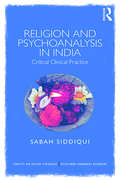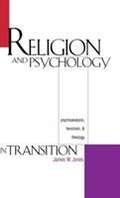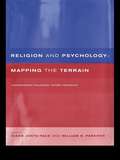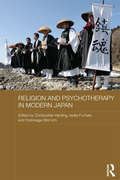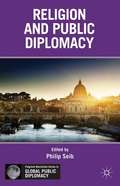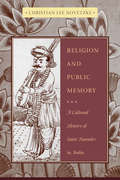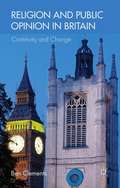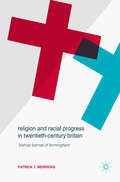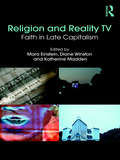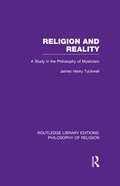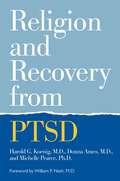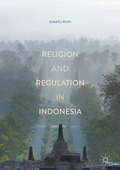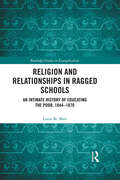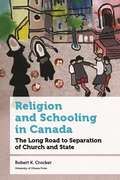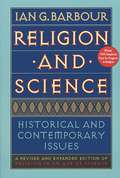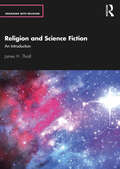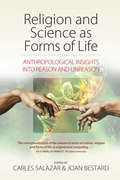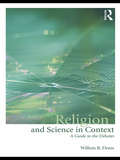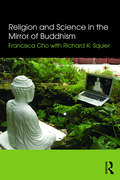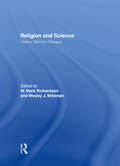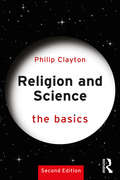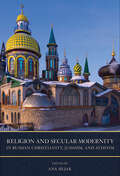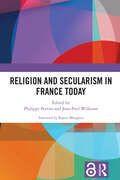- Table View
- List View
Religion and Psychoanalysis in India: Critical Clinical Practice (Concepts for Critical Psychology)
by Sabah SiddiquiReligion and Psychoanalysis in India questions the assumptions of an established scientific, evidence-based global mental health paradigm by examining the practices of faith-based healing. It proposes that human beings demonstrate a dual loyalty: to science as faith and faith as science, both of which get reconfigured in the process. In this particular context, science and faith are deployed in ways that are not only different but at times contrary to mainstream discourses of science and religion, and faith healing becomes a point where these two discourses collide head-on in negotiating cultural values and practices. The book addresses key questions, such as: What is the value of 'faith healing' in understanding distress and treatment in different cultural contexts? What is a critical psychological perspective on faith and religious systems? What challenges do alternative religious practices pose to critical psychology? How should we re-imagine clinical work in a context marked by science and religion? Situated between 'West' and 'East', between the global mental health movement and local faith-based practices in India, the book addresses a wide audience that includes students and researchers in psychology, cultural and medical anthropology, the sociology of religion, cultural theory, postcolonial theory, and the sociology of science. It will also appeal to policy-makers and practitioners interested in the work of NGOs and the legal frameworks driving mental health movements in India.
Religion and Psychology in Transition: Psychoanalysis, Feminism, and Theology
by James W. JonesIn this thought-provoking book, clinical psychologist and professor of religious studies James W. Jones presents a dialogue between contemporary psychoanalytic thinking and contemporary theology. He sheds new light on the interaction of religion and psychology by viewing it from the perspective of world religions, providing an epistemological framework for the psychology of religion that draws on contemporary philosophy of science, and bringing out the importance of gender as a category of analysis. Developments in psychoanalysis provide new resources for theological reflection, Jones contends. The Freudian view that human nature is isolated and instinctual has shifted to a vision of the self as constituted in and through relationships. Jones uses this relational model of human nature to explore the convergence between contemporary psychoanalysis, feminist theorizing, and themes in religious thought found in a variety of traditions. He also critiques the reductionism inherent in Freud's discussion of religion and proposes nonreductionistic and genuinely psychoanalytic ways for psychoanalysis to treat religious topics. For therapists, psychologists, theologians, and others interested in spiritual or psychological issues, Jones offers illuminating clinical material and insightful analysis.
Religion and Psychology: Mapping the Terrain
by Diane Jonte-Pace William B. ParsonsReligion and Psychology is a thorough and incisive survey of the current relationship between religion and psychology from the leading scholars in the field. This is an essential resource for students and researchers in the area of psychology of religion. Issues addressed are:* The Psychology-Theology Dialogue* The Psychology-Comparativist Dialogue* Psychology, Religion and Gender Studies* Psychology "as" Religion* Social Scientific Approaches to the Psychology of Religion* The Empirical Approach* International Perspectives
Religion and Psychotherapy in Modern Japan (Routledge Contemporary Japan Series)
by Christopher Harding Iwata Fumiaki Yoshinaga Shin’ichiSince the late nineteenth century, religious ideas and practices in Japan have become increasingly intertwined with those associated with mental health and healing. This relationship developed against the backdrop of a far broader, and deeply consequential meeting: between Japan’s long-standing, Chinese-influenced intellectual and institutional forms, and the politics, science, philosophy, and religion of the post-Enlightenment West. In striving to craft a modern society and culture that could exist on terms with – rather than be subsumed by – western power and influence, Japan became home to a religion--psy dialogue informed by pressing political priorities and rapidly shifting cultural concerns. This book provides a historically contextualized introduction to the dialogue between religion and psychotherapy in modern Japan. In doing so, it draws out connections between developments in medicine, government policy, Japanese religion and spirituality, social and cultural criticism, regional dynamics, and gender relations. The chapters all focus on the meeting and intermingling of religious with psychotherapeutic ideas and draw on a wide range of case studies including: how temple and shrine ‘cures’ of early modern Japan fared in the light of German neuropsychiatry; how Japanese Buddhist theories of mind, body, and self-cultivation negotiated with the findings of western medicine; how Buddhists, Christians, and other organizations and groups drew and redrew the lines between religious praxis and psychological healing; how major European therapies such as Freud’s fed into self-consciously Japanese analyses of and treatments for the ills of the age; and how distress, suffering, and individuality came to be reinterpreted across the twentieth and early twenty-first centuries, from the southern islands of Okinawa to the devastated northern neighbourhoods of the Tohoku region after the earthquake, tsunami, and nuclear disasters of March 2011. Religion and Psychotherapy in Modern Japan will be welcomed by students and scholars working across a broad range of subjects, including Japanese culture and society, religious studies, psychology and psychotherapy, mental health, and international history.
Religion and Public Diplomacy
by Philip SeibMixing religion and public diplomacy can produce volatile results, but in a world in which the dissemination and influence of religious beliefs are enhanced by new communications technologies, religion is a factor in many foreign policy issues and must be addressed. Faith is such a powerful part of so many people's lives that it should be incorporated in public diplomacy efforts if they are to have meaningful resonance among the publics they are trying to reach. This book addresses key issues of faith in an increasingly connected and religious world and provides a better understanding of the role religion plays in public diplomacy.
Religion and Public Memory: A Cultural History of Saint Namdev in India
by Christian Lee NovetzkeNamdev is a central figure in the cultural history of India, especially within the field of bhakti, a devotional practice that has created publics of memory for over eight centuries. Born in the Marathi-speaking region of the Deccan in the late thirteenth century, Namdev is remembered as a simple, low-caste Hindu tailor whose innovative performances of devotional songs spread his fame widely. He is central to many religious traditions within Hinduism, as well as to Sikhism, and he is a key early literary figure in Maharashtra, northern India, and Punjab. In the modern period, Namdev appears throughout the public spheres of Marathi and Hindi and in India at large, where his identity fluctuates between regional associations and a quiet, pan-Indian, nationalist-secularist profile that champions the poor, oppressed, marginalized, and low caste. Christian Lee Novetzke considers the way social memory coheres around the figure of Namdev from the sixteenth century to the present, examining the practices that situate Namdev's memory in multiple historical publics. Focusing primarily on Maharashtra and drawing on ethnographies of devotional performance, archival materials, scholarly historiography, and popular media, especially film, Novetzke vividly illustrates how religious communities in India preserve their pasts and, in turn, create their own historical narratives.
Religion and Public Opinion in Britain
by Ben ClementsBased on extensive analysis of surveys from recent decades, this book provides a detailed study of the attitudes of religious groups in Britain. It looks at continuity and change in relation to party support, ideology, abortion, homosexuality and gay rights, foreign policy, and public opinion towards religion in public life.
Religion and Public Policy: Human Rights, Conflict, and Ethics
by Sumner B. Twiss Marian Gh. Simion Rodney L. PetersenThis book pivots around two principal concerns in the modern world: the nature and practice of human rights in relation to religion, and the role of religion in perennial issues of war and peace. Taken collectively, the chapters articulate a vision for achieving a liberal peace and a just society firmly grounded in respect for human rights, while working in tandem with the constructive roles that religious ideas, leaders, and institutions can play even amid cultural difference. Topics covered include: the status and justification of human rights; the meaning and significance of religious liberty; whether human rights protections ought to be extended to other species; how the comparative study of religious ethics ought to proceed; the nature, limits, and future development of just war thinking; the role of religion and human rights in conflict resolution, diplomacy, and peace-building; and the tensions raised by religious involvement in public policy and state institutional practices. Featuring a group of distinguished contributors, this is a multifaceted and original exploration of the aforementioned themes.
Religion and Racial Progress in Twentieth-Century Britain
by Patrick T. MerricksThis book is the first in-depth analysis of Ernest William Barnes' Christian-eugenic philosophy: 'bio-spiritual determinism'. As a testament to the popularity of the movement, mid-twentieth century British eugenics is contextualized within a remarkably diverse selection of discourses including secular and Anglican interpretations of modernism, poverty, population, gender equality, pacifism and racism. This begins to address the scholastic gap on Christian eugenics while highlighting the perseverance of eugenic racism after World War Two.
Religion and Rational Theology
by Immanuel Kant Allen W. Wood George Di GiovanniThis volume collects for the first time in a single volume all of Kant's writings on religion and rational theology. These works were written during a period of conflict between Kant and the Prussian authorities over his religious teachings. His final statement of religion was made after the death of King Frederick William II in 1797. The historical context and progression of this conflict are charted in the general introduction to the volume and in the translators' introductions to particular texts. All the translations are new with the exception of The Conflict of the Faculties, where the translation has been revised and re-edited to conform to the guidelines of the Cambridge Edition. As is standard with all the volumes in this edition, there are copious linguistic and explanatory notes, and a glossary of key terms.
Religion and Reality TV: Faith in Late Capitalism
by Mara Einstein Katherine Madden Diane WinstonWhy is reality television flourishing in today's expanding media market? Religion and Reality TV: Faith in Late Capitalism argues that the reality genre offers answers to many of life's urgent questions: Why am I important? What gives my life meaning? How do I present my best self to the world? Case studies address these questions by examining religious representations through late capitalist lenses, including the maintenance of the self, the commodification of the sacred, and the performance of authenticity. The book's fourteen essays explore why religious themes proliferate in reality TV, audiences' fascination with "lived religion," and the economics that make religion and reality TV a successful pairing. Chapters also consider the role of race, gender, and religion in the production and reception of programming. Religion and Reality TV provides a framework for understanding the intersection of celebrity, media attention, beliefs, and values. The book will be of interest to students and scholars of religion and media studies, communication, American studies, and popular culture.
Religion and Reality: A Study in the Philosophy of Mysticism (Routledge Library Editions: Philosophy of Religion)
by James Henry TuckwellThis discussion of the search for religious truth addresses a universal view of religion that can be termed ‘philosophical mysticism’ from a rational basis of experience. Originally published in 1915, this is a classic of theological thinking that investigates the fundamental nature of religion and ‘perfect’ experience.
Religion and Recovery from PTSD
by Harold Koenig Donna Ames Michelle PearceThis volume focuses on the role that religion and spirituality can play in recovery from post-traumatic stress disorder (PTSD) and other forms of trauma, including moral injury. Religious texts, from the Bible to Buddhist scriptures, have always contained passages that focus on helping those who have experienced the trauma of war. Many religions have developed psychological, social, behavioral, and spiritual ways of coping and healing that can work in tandem with clinical treatments today in assisting recovery from PTSD and moral injury.In this book the authors review and discuss systematic research into how religion helps people cope with severe trauma, including trauma caused by natural disasters, intentional interpersonal violence, or combat experiences during war. They delve into the impact that spirituality has in both the development of and recovery from PTSD. Beyond reviewing research, they also use case vignettes throughout to illustrate the very human story of recovery from PTSD, and how religious or spiritual beliefs can both help or hinder depending on circumstance. A vital work for any mental health or religious professionals who seek to help people dealing with severe trauma and loss.
Religion and Regulation in Indonesia
by Ismatu RopiThis book analyses the relation between state and religion in Indonesia, considering both the philosophical underpinning of government intervention on religious life but also cases and regulations related to religious affairs in Indonesia. Examining state regulation of religious affairs, it focuses on understanding its origin, history and consequences on citizens' religious life in modern Indonesia, arguing that while Indonesian constitutions have preserved religious freedom, they have also tended to construct wide-ranging discretionary powers in the government to control religious life and oversee religious freedom. Over more than four decades, Indonesian governments have constructed a variety of policies on religion based on constitutional legacies interpreted in the light of the norms and values of the existing religious majority group. A cutting edge examination of the tension between religious order and harmony on one hand, and protecting religious freedom for all on the other, this book offers a cutting edge study of how the history of regulating religion has been about the constant negotiation for the boundaries of authority between the state and the religious majority group.
Religion and Relationships in Ragged Schools: An Intimate History of Educating the Poor, 1844-1870 (Routledge Studies in Evangelicalism)
by Laura M. MairFocusing on the interaction between teachers and scholars, this book provides an intimate account of "ragged schools" that challenges existing scholarship on evangelical child-saving movements and Victorian philanthropy. With Lord Shaftesbury as their figurehead, these institutions provided a free education to impoverished children. The primary purpose of the schools, however, was the salvation of children’s souls. Using promotional literature and local school documents, this book contrasts the public portrayal of children and teachers with that found in practice. It draws upon evidence from schools in Scotland and England, giving insight into the achievements and challenges of individual institutions. An intimate account is constructed using the journals maintained by Martin Ware, the superintendent of a North London school, alongside a cache of letters that children sent him. This combination of personal and national perspectives adds nuance to the narratives often imposed upon historic philanthropic movements. Investigating how children responded to the evangelistic messages and educational opportunities ragged schools offered, this book will be of keen interest to historians of education, emigration, religion, as well as of the nineteenth century more broadly.
Religion and Schooling in Canada: The Long Road to Separation of Church and State (Education)
by Robert K. CrockerLes organisations chrétiennes ont toujours été impliquées dans l’éducation canadienne. En 1949, cinq provinces comptaient des écoles confessionnelles protégées par la Constitution. Le gouvernement fédéral a essentiellement confié sa responsabilité de l’éducation pour les peuples autochtones aux églises pour plus d’un siècle. Résultat : une histoire de mauvais traitements seulement mise au jour récemment.Des années 1950 aux années 1970, plusieurs mesures dans diverses provinces ont posé les jalons pour d’importantes réformes en éducation. Certaines testaient les limites des protections confessionnelles, mais ne pouvaient éliminer les structures constitutionnelles sous-jacentes.Le rapatriement de la Constitution et l’adoption de la Charte des droits et libertés en 1982 ont codifié des changements fondamentaux dans la perception des droits civils. La Charte permettait des remises en question des droits confessionnaux sur plusieurs fronts, mais elles ont toutes été refusées par les tribunaux au motif que la Charte ne peut servir à déroger à d’autres parties de la Constitution.Dans les années 1990, le mode de révision se présente comme une autre voie vers la réforme. On a recouru à des modifications constitutionnelles pour mettre fin au contrôle confessionnel des écoles à Terre-Neuve et au Québec en 1997 et en 1998.Les circonstances entourant ces modifications constitutionnelles sont scrutées comme précédents possibles pour obtenir des résultats semblables en Alberta, en Ontario et en Saskatchewan. Cet ouvrage soutient que des changements y sont inévitables et présente plusieurs voies vers la réforme. Cette réforme vise à éliminer la discrimination inhérente dans les établissements confessionnels tout en préservant une participation religieuse dans certaines écoles.
Religion and Science
by Ian G. BarbourReligion and Science is a definitive contemporary discussion of the many issues surrounding our understanding of God and religious truth and experience in our understanding of God and religious truth and experience in our scientific age. This is a significantly expanded and feshly revised version of Religion in an Age of Science, winner of the American Academy of Religion Award for Excellence and the Templeton Book Award. Ian G. Barbour--the premier scholar in the field--has added three crucial historical chapters on physics and metaphysics in the seventeenth century, nature and God in the eighteenth century, and biology and theology in the nineteenth century. He has also added new sections on developments in nature-centered spirituality, information theory, and chaos and complexity theories.
Religion and Science Fiction: An Introduction (Engaging with Religion)
by James H. ThrallReligion and Science Fiction: An Introduction guides students into deeper understanding of how religion and science fiction engage often overlapping questions.This textbook introduces key ideas of religious studies through critical consideration of print and visual media that fall within the general category of science fiction. The goal throughout is to help students move beyond simply identifying points of interrelation between religious studies and forms of what is often called, more broadly, speculative fiction, to considering how the studied texts open new ways of thinking about human (and nonhuman) experience taken to be religious.With discussion questions, lists of key terms, extensive additional resources, and suggestions for projects and essay questions, this book is a foundational text for students and instructors of religion and science fiction.
Religion and Science as Forms of Life: Anthropological Insights into Reason and Unreason
by Carles Salazar Joan BestardThe relationships between science and religion are about to enter a new phase in our contemporary world, as scientific knowledge has become increasingly relevant in ordinary life, beyond the institutional public spaces where it traditionally developed. The purpose of this volume is to analyze the relationships, possible articulations and contradictions between religion and science as forms of life: ways of engaging human experience that originate in particular social and cultural formations. Contributions use this theoretical and ethnographic research to explore different scientific and religious cultures in the contemporary world.
Religion and Science in Context: A Guide to the Debates
by Willem B. DreesHow should we think about religion, science, and their relationship in modern society? Some religious groups oppose evolution; some atheists claim science is on their side. Others reconcile their beliefs with science, or consider science and faith to deal with fundamentally different aspects of human life. What indeed is religion: belief or trust in God’s existence? How do we distinguish sense from superstition? What does science have to say on such issues? Willem B. Drees considers contemporary discussions of these issues in Europe and North America, using examples from Christianity and religious naturalism, and reflections on Islam and Tibetan Buddhism. He argues that the scientific understanding leaves open certain ultimate questions, and thus allows for belief in a creator, but also for religious naturalism or serious agnosticism. By analysing the place of values in a world of facts, and the quest for meaningful stories in a material world, Religion and Science in Context offers an original and self-critical analysis of the field, its assumptions and functions, and ends with a vision of its possible future.
Religion and Science in the Mirror of Buddhism
by Francisca Cho Richard K. SquierThis book offers a Buddhist perspective on the conflict between religion and science in contemporary western society. Examining Buddhist history, authors Francisca Cho and Richard K. Squier offer a comparative analysis of Buddhist and western scientific epistemologies that transcends the limitations of non-Buddhist approaches to the subject of religion and science. The book is appropriate for undergraduates, graduate students, and researchers interested in comparative religion or in the intersection of religion and science and Buddhist Studies.
Religion and Science: History, Method, Dialogue
by Wesley J. Wildman W. Mark RichardsonEmphasizing its historical, methodological and constructive dimensions, Religion and Science takes the pulse of pertinent current research as the interdisciplinary study of science and religion gains momentum.
Religion and Science: The Emergence Of Spirit In The Natural World. Frankfurt Templeton Lectures 2006 (The Basics #13)
by Philip ClaytonReligion and science are arguably the two most powerful social forces in the world today. But where religion and science were once held to be compatible, many people now perceive them to be in conflict. This unique book provides the best available introduction to the burning debates in this controversial field. Examining the defining questions and controversies, renowned expert Philip Clayton presents the arguments from both sides, asking readers to decide for themselves where they stand: • science or religion, or science and religion? • history and philosophy of science • the role of scientific and religious ethics – modifying genes, extending life, and experimenting with human subjects • religion and the environmental crisis • the future of science vs. the future of religion. Thoroughly updated throughout, this second edition explores religious traditions from around the world and provides insights from across the sciences, making this book essential reading for all those wishing to come to their own understanding of some of the most important debates of our day.
Religion and Secular Modernity in Russian Christianity, Judaism, and Atheism (NIU Series in Slavic, East European, and Eurasian Studies)
by Edited by Ana SiljakReligion and Secular Modernity in Russian Christianity, Judaism, and Atheism is a multifaceted account of the engagement between religion and the secular in Russia's Christian, Jewish, and atheist traditions. Ana Siljak brings together an interdisciplinary group of leading scholars to present unique perspectives on the secularization dynamic in Russia and the Soviet Union, telling stories about theologians, sects, churches, poets, and artists. From the Jewish Christian priest Alexander Men, to the cross-dressing poet Zinaida Gippius, to the Soviet promoter of Yiddish theater Solomon Mikhoels, Religion and Secular Modernity in Russian Christianity, Judaism, and Atheism gives a voice to a variety of actors who have grappled with the possibilities of faith and unbelief in an industrialized, modern, and seemingly secular world. Now more than ever, as one narrative of Russia's religious history dominates official Russian accounts, alternative perspectives of the relationship between Russian religion and secularism should be highlighted and emphasized.
Religion and Secularism in France Today
by Jean-Paul Willaime Philippe PortierThis volume explores the dynamic life of religion and politics in France. The separation of church and state and the autonomy of school education from religion are the two fundamental pillars of France as a secular republic. The historical construction of French secularism (laïcité) was particularly marked by the strong opposition between the state and the Catholic church. However, the religious disaffiliation of a significant proportion of the French strengthened state secularism, which gradually became more consensual – despite some persisting tensions in the school context. Yet, in the last decades, several factors have revived public debate on laicity: the quarrel over ‘sects’ and new religious movements; controversies over Islam, today the second-largest religion in France; and, more recently, dispute over bioethics. Faced with these challenges, laicity as well as the religious groups involved have been changing. The authors of this book, ranking amongst the best French experts in the study of religion and secularism, introduce the reader to a living and lived laicity influenced by the social and religious dynamics of contemporary France. They demonstrate that the configurations of French secularism are both more flexible and complex than they appear to be. The volume investigates the extent to which the French idea of secularization has been pushed to be more thorough and radical in its interaction with its other European counterparts. A key work on French political thought, this volume will be of great interest to scholars and researchers of international politics, political philosophy, political sociology, and religion and politics.
